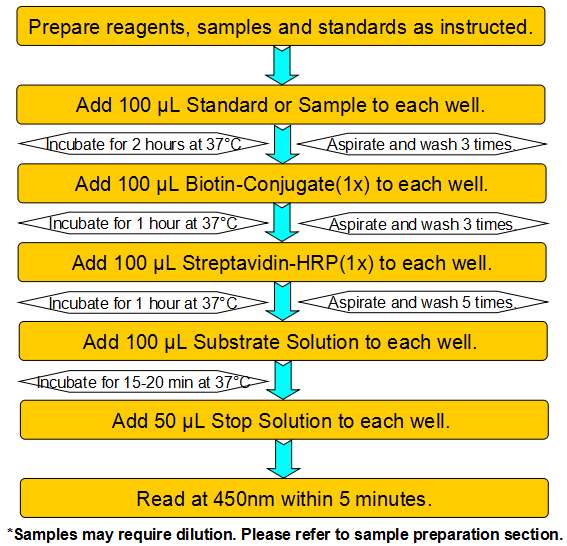Product Details
| Species Reactivity |
N/A |
| UniProt |
N/A |
| Abbreviation |
Dimetridazole |
| Alternative Names |
N/A |
| Range |
0.01-0.81 ppb |
| Sensitivity |
0.01 ppb |
| Sample Type |
tissue, honey, raw milk, raw egg, cooked egg |
| Detection Method |
Competitive ELISA |
| Analysis Method |
Quantitive |
| Assay Duration |
1-3h |
| Sample Volume |
10-200 μL |
| Detection Wavelengt |
450 nm |
Test principle
This assay is based on the competitive enzyme immunoassay for the detection of Dimetridazole in the sample. The coupling antigens are pre-coated on the micro-well stripes. The Dimetridazole in the sample and the coupling antigens pre-coated on the micro-well stripes compete for the anti-Dimetridazole antibodies. After the addition of the enzyme conjugate, the TMB substrate is added for coloration. The optical density (OD) value of the sample has a negative correlation with the Dimetridazole in it. This value is compared to the standard curve and the Dimetridazole concentration is subsequently obtained.
Product Overview
Dimetridazole is a nitroimidazole class drug that combats protozoan infections. Target: Antiparasitic Dimetridazole (DMZ) is a 5-nitroimidazole drug traditionally used for the prevention and treatment of histomoniasis in turkeys, trichomoniasis in pigeons, genital trichomoniasis in cattle and the prevention and treatment of haemorrhagic enteritis in pigs.
Components
Reagents |
Quantity |
Reagents |
Quantity |
Assay plate (96 Wells) |
1 |
Instruction manual |
1 |
Standards |
6 x 1 mL |
Redissolving Solution (concentrate 2 x) |
2 x 20 mL |
Antibody |
1 x 6 mL |
HRP-Conjugate |
1 x 6 mL |
Wash Buffer (concentrate 20 x) |
1 x 20 mL |
Stop Solution |
1 x 6 mL |
Substrate A |
1 x 6 mL |
Substrate B |
1 x 6 mL |
Adhesive Films |
4 |
|
|
Recovery
Sample Type |
Number |
Recovery range (%) |
Average(%) |
Serum |
10 |
90-101 |
96 |
EDTA plasma |
10 |
89-97 |
93 |
Heparin plasma |
10 |
91-99 |
95 |
Precision
Intra-assay Precision (Precision within an assay)
Three samples of known concentration were tested twenty times on one plate to assess intra-assay precision.
Inter-assay Precision (Precision between assays)
Three samples of known concentration were tested in forty separate assays to assess inter-assay precision.
CV (%) = SD/meanX100
Intra-Assay: CV<8%
Inter-Assay: CV<12%
Linearity
Sample Type |
1:2 |
1:4 |
1:8 |
1:16 |
Serum |
78-89% |
81-99% |
92-103% |
95-105% |
EDTA plasma |
91-101% |
90-98% |
93-101% |
91-98% |
Heparin plasma |
92-103% |
93-102% |
92-99% |
91-101% |
Stability
The stability of ELISA kit is determined by the loss rate of activity. The loss rate of this kit is less than 5% within the expiration date under appropriate storage condition.
The loss rate was determined by accelerated thermal degradation test. Keep the kit at 37°C for 4 and 7 days, and compare O.D.values of the kit kept at 37°C with that of at recommended temperature. (referring from China Biological Products Standard, which was calculated by the Arrhenius equation. For ELISA kit, 4 days storage at 37°C can be considered as 6 months at 2 - 8°C, which means 7 days at 37°C equaling 12 months at 2 - 8°C).
Sample collection and storage
Store at 2-8°C. Please refer to Instruction Manual.
Kits storage instructions
Store at 2-8°C. Please refer to Instruction Manual.



